Highlights of QB3-Berkeley research, awards, and events news from 2017.
 December 20, 2017 – First Step Toward CRISPR Cure of Lou Gehrig’s Disease
December 20, 2017 – First Step Toward CRISPR Cure of Lou Gehrig’s Disease
David Schaffer and his research team have for the first time used CRISPR-Cas9 gene editing to disable a defective gene that causes amyotrophic lateral sclerosis, or Lou Gehrig’s disease, in mice, extending their lifespan by 25 percent. The therapy delayed the onset of the muscle wasting that characterizes the disease, which results in progressive weakness and eventually proves fatal when the muscles that control breathing fail. More >
 November 16, 2017 – Detailed View of Immune Proteins Could Lead to New Pathogen-Defense Strategies
November 16, 2017 – Detailed View of Immune Proteins Could Lead to New Pathogen-Defense Strategies
Eva Nogales and her colleagues have resolved the structure of a ring of proteins used by the immune system to summon support when under attack, providing new insight into potential strategies for protection from pathogens. Their study used cryo-electron microscopy to capture a high-resolution image of a protein ring called an “inflammasome” as it was bound to flagellin, a protein from the whiplike tail used by bacteria to propel themselves forward. More >
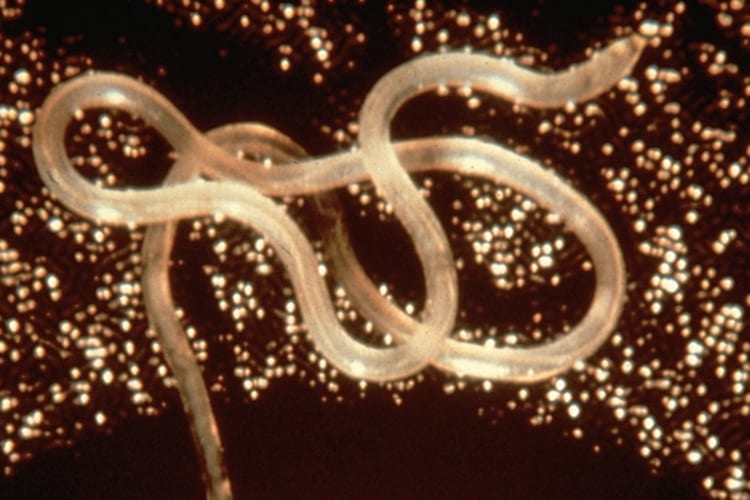 November 9, 2017 – A Cellphone-based Microscope for Treating River Blindness
November 9, 2017 – A Cellphone-based Microscope for Treating River Blindness
A smartphone-based microscope technology developed by Daniel Fletcher and his colleagues has been used to help treat river blindness, a debilitating disease caused by parasitic worms. The technology, called LoaScope, uses video from a smartphone-connected microscope to automatically detect and quantify infection by parasitic worms in a drop of blood. This work sets the stage for expanding the use of mobile microscopy to improve diagnosis and treatment of other diseases, both in low-resource areas and eventually back in the U.S. More >
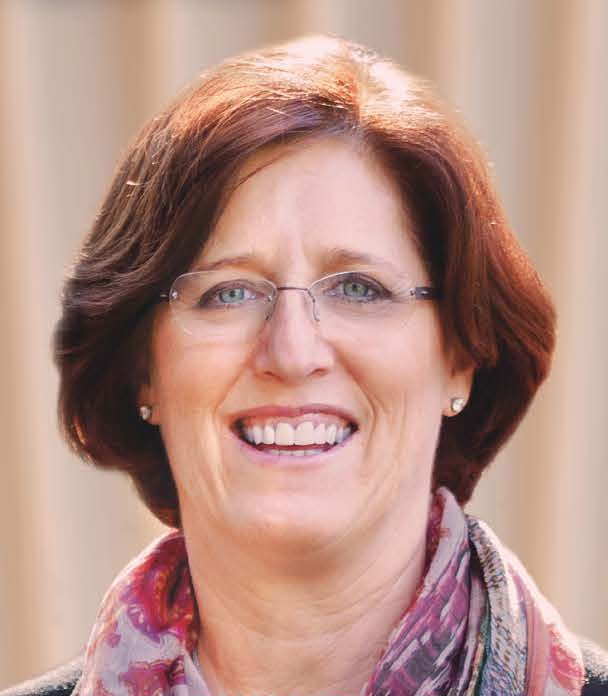 November 1, 2017 – Marqusee Receives Lifetime Achievement Award
November 1, 2017 – Marqusee Receives Lifetime Achievement Award
The Stanford Medicine Alumni Association has announced that Susan Marqusee will receive the prestigious Arthur Kornberg and Paul Berg Lifetime Achievement Award in Biomedical Sciences. Marqusee, one of the leading scientists in protein folding, will be honored for her extraordinary advances impacting medical science and education, including the first de novo design of a short peptide that folds into a specific structure, the application of hydrogen exchange methods to measure rare partially structured conformers, and the mechanical manipulation of single protein molecules. More >
 October 23, 2017 – $65.5 Million from NIH to Create Brain Atlas
October 23, 2017 – $65.5 Million from NIH to Create Brain Atlas
UC Berkeley is partnering with the Allen Institute for Brain Science in Seattle on a $65.5 million, five-year effort to count, catalog and connect the many different cell types in the mouse brain, as a foundation for doing the same for the human brain. The effort is part of the federal government’s BRAIN Initiative, with the ultimate goal of understanding brain circuits well enough to devise new therapies for diseases of the human brain and nervous system. More >
 October 5, 2017 – Garcia Receives New Innovator Grant
October 5, 2017 – Garcia Receives New Innovator Grant
Hernan Garcia has received a New Innovator Award from the National Institutes of Health that provides $1.5 million over five years to pursue high-risk, high-reward work that could have implications for human health. Garcia, an assistant professor of molecular and cell biology and of physics, combines physics with synthetic biology to understand how cells determine their fate, that is, what genes are activated as a cell specializes to become a nerve cell, for example, rather than a liver cell. More >
 October 4, 2017 – Berkeley Tech Brings Nobel-Winning Cryo-EM into Sharper Focus
October 4, 2017 – Berkeley Tech Brings Nobel-Winning Cryo-EM into Sharper Focus
Pioneering work by scientists such as Robert Glaeser played a key role in the 2017 Nobel Prize in chemistry honoring the development of cryo-electron microscopy, or cryo-EM, an imaging technique that has launched the fields of structural biology and biochemistry into an exciting new era of discovery. Glaeser and colleagues were among the first to show the importance of freezing samples to liquid nitrogen temperatures to protect them from the damage of intense electron beams. More >
 October 3, 2017 – CRISPR-Gold Fixes Duchenne Muscular Dystrophy Mutation in Mice
October 3, 2017 – CRISPR-Gold Fixes Duchenne Muscular Dystrophy Mutation in Mice
Scientists led by Niren Murthy and Irina Conboy have engineered a new way to deliver CRISPR-Cas9 gene-editing technology inside cells and have demonstrated in mice that the technology can repair the mutation that causes Duchenne muscular dystrophy, a severe muscle-wasting disease. This may lead to a new approach to treating genetic diseases. More >
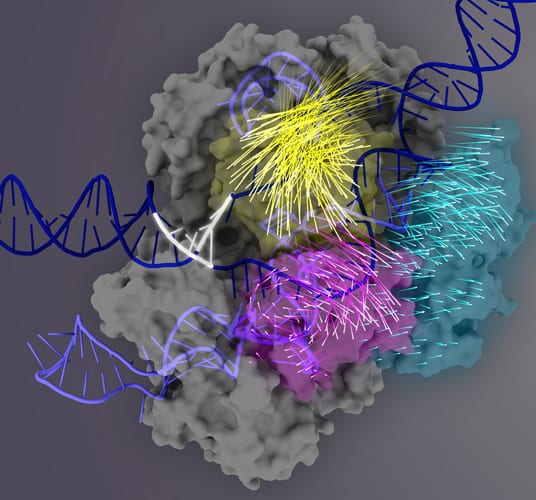 September 20, 2017 – Discovery Helps Engineer More Accurate Cas9s for CRISPR Editing
September 20, 2017 – Discovery Helps Engineer More Accurate Cas9s for CRISPR Editing
Scientists at UC Berkeley and Massachusetts General Hospital have identified a key region within the Cas9 protein that governs how accurately CRISPR-Cas9 homes in on a target DNA sequence, and have tweaked it to produce a hyper-accurate gene editor with the lowest level of off-target cutting to date. More >
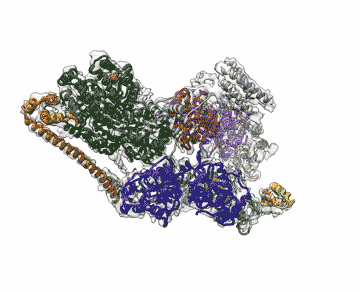 September 13, 2017 – Scientists Map Key DNA Protein Complex at Near-Atomic Resolution
September 13, 2017 – Scientists Map Key DNA Protein Complex at Near-Atomic Resolution
Chalking up another success for a new imaging technology (cryo-electron microscopy or cryo-EM) that has energized the field of structural biology, Eva Nogales and her research colleagues have obtained the highest resolution map yet of a large assembly of human proteins that is critical to DNA function. The goal is to better understand how the molecules function so that researchers can develop finely targeted therapies with more predictive power. More >
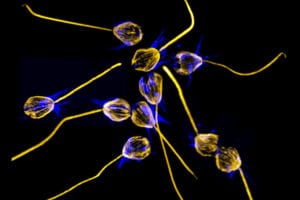 September 1, 2017 – Bacteria Act as Aphrodisiac for the Closest Relatives of Animals
September 1, 2017 – Bacteria Act as Aphrodisiac for the Closest Relatives of Animals
Nicole King and her research colleagues have discovered that bacteria can act as an aphrodisiac for one-celled marine organisms notable for being the closest living relatives of all animals. This is the first known example of bacteria triggering mating in a eukaryote, a group that includes all plants and animals. More >
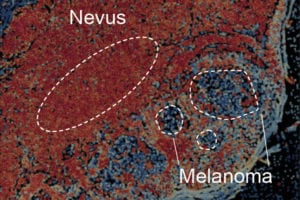 August 17, 2017 – Two-Step Process Leads to Cell Immortalization and Cancer
August 17, 2017 – Two-Step Process Leads to Cell Immortalization and Cancer
A mutation that helps make cells immortal is critical to the development of a tumor, but new research by Dirk Hockemeyer and his colleagues suggests that becoming immortal is a more complicated process than originally thought. The key to immortalization is an enzyme called telomerase, which keeps chromosomes healthy in cells that divide frequently. The mutation in some cells slightly raises levels of telomerase, which keep the cells alive long enough for a second change, still unknown, that stimulates the production of telomerase which in turn helps make the cells immortal and malignant. More >
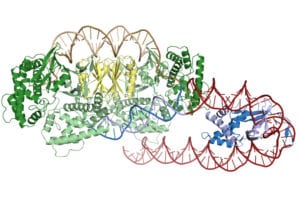 July 20, 2017 – Researchers Discover How CRISPR Proteins Find Their Target
July 20, 2017 – Researchers Discover How CRISPR Proteins Find Their Target
Jennifer Doudna, Eva Nogales, and their colleagues have discovered how Cas1-Cas2, the proteins responsible for the ability of the CRISPR immune system in bacteria to adapt to new viral infections, identify the site in the genome where they insert viral DNA so they can recognize it later and mount an attack. The discovery opens the door for modification of the proteins themselves and thus possibly expand their application into organisms without their own CRISPR locus. More >
 July 18, 2017 – Making Chicken Feathers
July 18, 2017 – Making Chicken Feathers
The rubber-like elasticity of skin, which contracts to its original shape after being stretched, is key to the development of regularly spaced hairs and sweat glands during development, according to new research at UC Berkeley. The findings, which come from experiments on how chicken skin generates feathers as the embryo develops inside the egg, could provide tips on how to grow artificial skin for grafts that looks like normal human skin, complete with hair follicles and sweat pores. More >
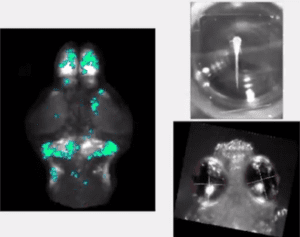 July 13, 2017 – $21.6 Million Funding from DARPA to Build Window into the Brain
July 13, 2017 – $21.6 Million Funding from DARPA to Build Window into the Brain
The Defense Advanced Research Projects Agency has awarded the University of California, Berkeley $21.6 million over four years to create a window into the brain through which researchers – and eventually physicians – can monitor and activate thousands to millions of individual neurons using light. This would be a first step toward replacing a damaged eye with a device that directly talks to the visual part of the cerebral cortex, or relaying touch sensation from an artificial limb to the touch part of the cortex to help an amputee control an artificial limb. More >
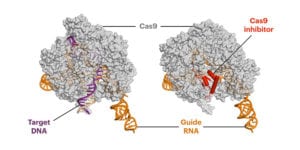 July 12, 2017 – Anti-CRISPR Proteins Decrease Off-Target Side Effects of CRISPR-Cas9
July 12, 2017 – Anti-CRISPR Proteins Decrease Off-Target Side Effects of CRISPR-Cas9
CRISPR-Cas9 gene editing is based on a tactic bacteria developed to protect themselves from viruses. Research from UC Berkeley and UC San Francisco now shows that the countermeasure viruses came up with — inhibitory proteins referred to as anti-CRISPRs — can be used to improve CRISPR-Cas9 as a gene-therapy tool, decreasing off-target gene editing that could cause unwanted side effects. More >
 July 5, 2017 – Smelling Your Food Makes You Fat
July 5, 2017 – Smelling Your Food Makes You Fat
A new study by Andrew Dillin and his colleagues has revealed a possible connection between the olfactory or smell system and regions of the brain that regulate metabolism. The findings suggest that the odor of what we eat may play an important role in how the body deals with calories. If you can’t smell your food, you may burn it rather than store it. This suggests there may be possible interventions for those who have lost their smell as well as for those having trouble losing weight. More >
 July 5, 2017 – Paul Alivisatos Named Executive Vice Chancellor and Provost
July 5, 2017 – Paul Alivisatos Named Executive Vice Chancellor and Provost
Paul Alivisatos, an internationally renowned chemist and UC Berkeley’s vice chancellor for research, has been chosen to serve as the campus’s new executive vice chancellor and provost. Former director of the Lawrence Berkeley National Laboratory, Alivisatos has been a UC Berkeley professor of chemistry since 1988 and is a serial entrepreneur. More >
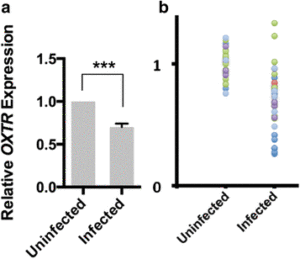 June 8, 2017 – Viral Infections Decrease Muscle Health, Cause Other Collateral Damage
June 8, 2017 – Viral Infections Decrease Muscle Health, Cause Other Collateral Damage
Researchers led by Irina Conboy have found unexpected effects of viral infections, a discovery that may explain why viruses can make people feel so lousy. They found that viral infections turn down the intensity of a key cell-signaling pathway linked to healing and health of skeletal muscle and bone, mental well-being and prevention of obesity. The signaling pathway, called oxytocin receptor MAPK, or OXTR, has been well studied for its role in trust and bonding and more recently was found to be needed for muscle maintenance and regeneration, which declines with age. More >
 May 11, 2017 – Sniffing Out Stem Cell Fates in the Nose
May 11, 2017 – Sniffing Out Stem Cell Fates in the Nose
Adult stem cells have the ability to transform into many types of cells, but tracing the path individual stem cells follow as they mature and identifying the molecules that trigger these fateful decisions are difficult in a living animal. John Ngai and his fellow neuroscientists have now combined new techniques for sequencing the RNA in single cells with detailed statistical analysis to more easily track individual stem cells in the nose, uncovering clues that someday could help restore smell to those who have lost it. More >
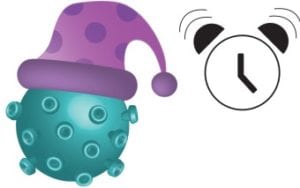 May 8, 2017 – Baiting the Bug
May 8, 2017 – Baiting the Bug
The difficulty in fighting HIV is its resilience. This is because the virus essentially hides in the body, making it less likely to succumb to anti-viral medication. Several recent studies from the labs of Qiang Zhou and Jim Hurley have rekindled the hope of curing an HIV infection by luring it out of its latent state, making treatment much more effective. More >
 May 4, 2017 – Pac-Man-like CRISPR Enzymes Have Potential for Disease Diagnostics
May 4, 2017 – Pac-Man-like CRISPR Enzymes Have Potential for Disease Diagnostics
Jennifer Doudna and her research colleagues at UC Berkeley and the Broad Institute have described 10 new CRISPR enzymes that, once activated, behave like Pac-Man to chew up RNA in a way that could be used as sensitive detectors of infectious viruses and cancer. More >
 April 26, 2017 – David Chandler, Pillar of Physical Chemistry, Dies at the Age of 72
April 26, 2017 – David Chandler, Pillar of Physical Chemistry, Dies at the Age of 72
David Chandler, pillar of the physical chemistry scientific community and Professor Emeritus of Chemistry at UC Berkeley, died April 18, 2017 after a valiant twenty-year battle with prostate cancer. Spanning a career that changed the course of the field of physical chemistry, not just once but several times, he is credited with crafting the modern language and concepts for describing structure and dynamics of condensed matter, especially complex systems with disorder and heterogeneity, such as liquids, glasses and biological assemblies. More >
 April 12, 2017 – The American Academy of Arts and Sciences Elects Cate and Chang as Members
April 12, 2017 – The American Academy of Arts and Sciences Elects Cate and Chang as Members
Jamie Cate and Christopher Chang have been elected members of the American Academy of Arts and Sciences, the esteemed society of scholars, scientists, writers, artists, as well as civic, business and philanthropic leaders from around the world. Cate is a leader in the field of ribosome function and translation, while Chang’s work involves developing molecules to probe the roles of metals and oxidation chemistry in the brain as well as in aging and neurodegenerative diseases.More >
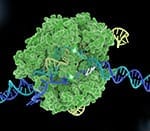 March 28, 2017 – European Patent Office to Grant UC a Broad Patent on CRISPR-Cas9
March 28, 2017 – European Patent Office to Grant UC a Broad Patent on CRISPR-Cas9
The European Patent Office will grant a broad patent for the revolutionary CRISPR-Cas9 gene-editing technology to the University of California, the University of Vienna, and Emmanuelle Charpentier. The patent will cover cells of all types, including human cells. The technology was invented by Jennifer Doudna, Emmanuelle Charpentier, and their colleagues. Applications include treatment of various human diseases, as well as veterinary, agricultural and other biotech applications. More >
 March 23, 2017 – In a Sample of Blood, Researchers Probe for Cancer Clues
March 23, 2017 – In a Sample of Blood, Researchers Probe for Cancer Clues
One day, patients may be able to monitor their body’s response to cancer therapy just by having their blood drawn. A new study led by Amy Herr has taken an important step in that direction by measuring a panel of cancer proteins in rare, individual tumor cells that float in the blood. The researchers are expanding the number of proteins identifiable using a microfluidic device they have developed. This technology will eventually allow pathologists to classify cancer cells more precisely than is possible using existing biomarkers. More >
 March 21, 2017 – New Drug Strategy: Target Ribosome to Halt Protein Production
March 21, 2017 – New Drug Strategy: Target Ribosome to Halt Protein Production
Jamie Cate and his colleagues report finding a small molecule that is able to block the production of a specific protein involved in LDL turnover by stalling only the ribosome that produces that protein. The discovery of a chemical compound that halts the production of a small set of proteins while leaving general protein production untouched suggests a new drug search strategy: Find compounds that target undesired proteins before they are even made. More >
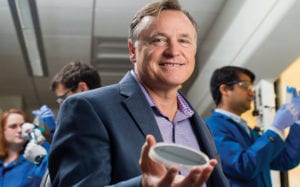 March 9, 2017 – Berkeley Engineers Join $24 Million Push for Craniofacial Repair Therapies
March 9, 2017 – Berkeley Engineers Join $24 Million Push for Craniofacial Repair Therapies
UC Berkeley is part of a California-based, six-university consortium that has been awarded $12 million by the National Institutes of Health to develop strategies for treating craniofacial defects, which affect millions of Americans. Kevin Healy leads Berkeley’s research efforts in new consortium. More >
 March 8, 2017 – Oral Delivery System Could Make Vaccinations Needle-Free
March 8, 2017 – Oral Delivery System Could Make Vaccinations Needle-Free
Patients could one day self-administer vaccines using a needleless, pill-sized technology that jet-releases a stream of vaccine inside the mouth, according to a proof-of-concept study conducted by researchers in QB3-Berkeley labs. The researchers are considering other shapes, sizes and designs to simplify vaccine administration procedures and increase patient compliance. More >
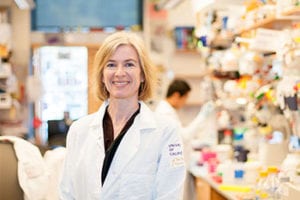 February 15, 2017 – Appeals Board Clears Way for UC Berkeley to Receive Patent on CRISPR-Cas9 Gene Editing
February 15, 2017 – Appeals Board Clears Way for UC Berkeley to Receive Patent on CRISPR-Cas9 Gene Editing
The Patent Trial and Appeal Board (PTAB) of the U.S. Patent and Trademark Office (USPTO) today ruled that the inventions claimed in the pending U.S. patent application filed by the Jennifer Doudna/Emmanuelle Charpentier research group and the patents and applications filed by the Broad Institute are separately patentable from one another, thereby moving the Doudna/Charpentier group’s application closer to issuance as a U.S. patent. More >
 February 9, 2017 – Chemicals Hitch a Ride onto New Protein for Better Compounds
February 9, 2017 – Chemicals Hitch a Ride onto New Protein for Better Compounds
Christopher Chang and his colleagues have developed a powerful new method of selectively linking chemicals to proteins, a major advance in the manipulation of biomolecules that could transform the way drugs are developed, proteins are probed, and molecules are tracked and imaged. The new method could fundamentally change the process of bioconjugation, the process by which chemicals and tags are attached to biomolecules, particularly proteins. More >
 February 8, 2017 – CZ Biohub Awards Nearly $14.5 million to Berkeley Researchers
February 8, 2017 – CZ Biohub Awards Nearly $14.5 million to Berkeley Researchers
Eight QB3-Berkeley researchers are among 47 new investigators chosen by the Chan Zuckerberg Biohub to receive up to $1.5 million each over the next five years to conduct cutting-edge biomedical research — with no strings attached. The CZ Biohub seeks to foster unconventional scientific exploration and encourage researchers to invent new tools to accelerate the pace of discovery. More >
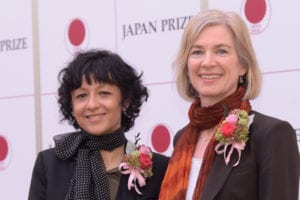 February 2, 2017 – Doudna Receives 2017 Japan Prize
February 2, 2017 – Doudna Receives 2017 Japan Prize
Jennifer Doudna and her colleague Emmanuelle Charpentier are being honored with the 2017 Japan Prize in Life Sciences for deciphering the molecular details of the type II bacterial immune system CRISPR-Cas and the creation of the CRISPR-Cas9 genome editing system, a revolutionary technique in genetic engineering, far more economical and faster than those previously available. More >
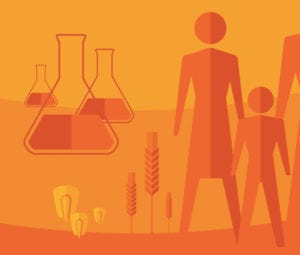 January 24, 2017 – CRISPR Research Institute Expands into Agriculture, Microbiology
January 24, 2017 – CRISPR Research Institute Expands into Agriculture, Microbiology
An initiative launched two years ago by UC Berkeley and UC San Francisco to use CRISPR-Cas9 gene editing to develop new disease therapies is expanding into research on the planet’s major crops and poorly understood microbiomes, with plans to invest $125 million in these areas over the next five years. More >
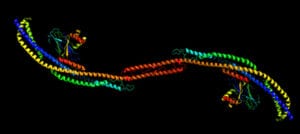 January 17, 2017 – Aiding Cells’ Strategy to Survive
January 17, 2017 – Aiding Cells’ Strategy to Survive
Cells don’t consume every protein they are offered, and leftovers can build up, clogging metabolism and threatening cell survival. Protein production can also go awry. The Bakar Fellows Program supports research by biochemist James Hurley to develop a new drug to boost the natural process that sweeps these threats away.
More >
Faculty Media Mentions, 2017
November 17, 2017, Nature Communications
The Energy Cost of Polypeptide Knot Formation and Its Folding Consequences
October 6, 2017, Futurism
CRISPR Is on the Cusp of Eradicating a Host of Diseases
October 6, 2017, Chemistry World
First for Cells As They’re Made to Manufacture Fluorinated Bioplastics
July 7, 2017, eLife
Deconstruction of the Ras Switching Cycle Through Saturation Mutagenesis
July 6, 2017, Science
Sea Anemone Genome Reveals Ancestral Eumetazoan Gene Repertoire and Genomic Organization
June 29, 2017, Washington Post
New Gene-editing Tool Could Cure Disease. Or Customize Kids. Or Aid Bioterrorism.
June 20, 2017, Protein Science
Molecular Machines One Molecule at a Time
April 18, 2017, c&en
CRISPR Pioneer Jennifer Doudna Shares Her Outlook for the Groundbreaking Gene-editing Tool
February 16, 2017, Newsweek
Meet the Scientist Bringing Gene Editing to Life: An Interview With Jennifer Doudna
January 11, 2017, ACS Central Science
Quantifying Hormone Disruptors with an Engineered Bacterial Biosensor
January 4, 2017, Science Translational Medicine
Targeted Clinical Control of Trauma Patient Coagulation Through a Thrombin Dynamics Model
Faculty Awards News Archive – 2017
 November 20, 2017 – Arkin R&D 100 Award Recipient
November 20, 2017 – Arkin R&D 100 Award Recipient
Adam Arkins and his colleagues are recipients of an R&D 100 Award for their Double Barcoded Shotgun Expression Library Sequencing (Dub-seq) technology, which can be used for discovering the functions of genes in microbes under different environmental conditions.
More >
 September 12, 2017 – Herr Honored with Visionary Award
September 12, 2017 – Herr Honored with Visionary Award
Amy Herr, professor of bioengineering and co-founder of the protein-analysis company Zephyrus Biosciences, was one of the winners of the Berkeley Chamber of Commerce’s Visionary of the Year award. The awards go to innovators with “imagination and persistence” who live or work in Berkeley. Herr’s work has revealed a process to analyze cell protein levels, which could lead to better treatment of diseases like cancer. More >
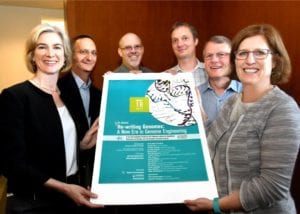 September 5, 2017 – Fifth Annual Berkeley Symposium Attracts Genome-Editing Pioneers
September 5, 2017 – Fifth Annual Berkeley Symposium Attracts Genome-Editing Pioneers
For a fifth straight year, the Re-writing Genomes symposium brought together leading experts to present a range of topics spanning molecular mechanisms of CRISPR proteins to cutting-edge clinical applications. The event was sponsored jointly by the California Institute for Quantitative Biosciences (QB3) at Berkeley and the Innovative Genomics Institute (IGI) and organized by Dirk Hockemeyer and Jennifer Doudna. More >
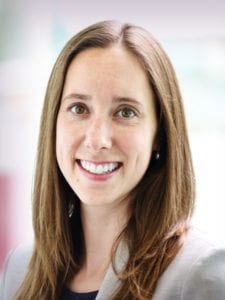 September 2017 – Rachel Haurwitz Named MIT Innovator Under 35
September 2017 – Rachel Haurwitz Named MIT Innovator Under 35
Alumna Rachel Haurwitz, former Doudna lab member, was named one of 35 Innovators Under 35 in MIT Technology Review. Haurwitz is President and Chief Executive Officer of Caribou Biosciences, which got its start in Stanley Hall’s QB3 Garage and is pioneering the translation of CRISPR-Cas genome engineering into new medical therapies and bio-based products. More >
 July 5, 2017 – Helium Ion Microscope Research Highlighted at ZEISS Event
July 5, 2017 – Helium Ion Microscope Research Highlighted at ZEISS Event
Helium Ion Microscope (HIM) research conducted at QB3-Berkeley’s Biomolecular Nanotechnology Center (BNC) was recently showcased by Frances Allen at the Grand Opening of the new ZEISS Customer Center in Pleasanton, CA. Diverse projects were presented in which the ion microscope is used to create images and to fabricate at the nanoscale with diverse applications in materials and life science. More >
 May 15, 2017 – Michael Botchan Appointed Dean of Biological Sciences
May 15, 2017 – Michael Botchan Appointed Dean of Biological Sciences
Michael Botchan, interim dean of the Division of Biological Sciences in the College of Letters and Science at UC Berkeley, has been appointed to be permanent dean of the division. He has held the position on an interim basis since July 1, 2016. His scholarly work at UC has included contributions to virology and to unraveling the mechanisms of DNA replication. More >
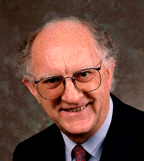 May 2, 2017 – Clarke Named to the American Philosophical Society
May 2, 2017 – Clarke Named to the American Philosophical Society
John Clarke has been honored with election to the American Philosophical Society. A professor of the graduate school in physics and a Berkeley Lab scientist. He is noted for his work on superconductivity, particularly the development and application of ultrasensitive SQUIDs (superconducting quantum interference devices). More >
 April 26, 2017 – Healy receives Humboldt Research Award
April 26, 2017 – Healy receives Humboldt Research Award
Kevin Healy has been elected the recipient of a Humboldt Research Award. This award is conferred in recognition of lifetime achievements in research by nomination from a peer. In addition, Healy is invited to carry out research projects of his choice in cooperation with specialist colleagues in Germany. More >
 April 18, 2017 – Kuriyan Wins Protein Society Award
April 18, 2017 – Kuriyan Wins Protein Society Award
John Kuriyan is the winner of the Protein Society’s Stein & Moore Award, which is given to recognize eminent leaders in protein science who have made sustained high impact research contributions to the field. Kuriyan’s major scientific contributions have been in understanding the regulation of eukaryotic cell signaling and the phenomenon of processivity in DNA repair. More >
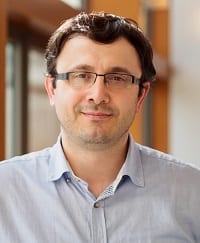 February 3, 2017 – Yildiz Receives Vilcek Prize for Creative Promise in Biomedical Science
February 3, 2017 – Yildiz Receives Vilcek Prize for Creative Promise in Biomedical Science
Ahmet Yildiz has been awarded the Vilcek Prize for Creative Promise in Biomedical Science for developing biological imaging methods that allowed for the visualization of molecules at a then-unprecedented scale, and employing those methods to unravel the mechanism of action of molecular motors within cells. He will be honored at a ceremony in New York City in April. More >
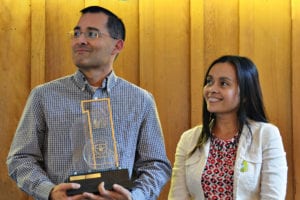 February 2, 2017 – Schaffer and Ramey win Grand Prize for Laboratory Safety
February 2, 2017 – Schaffer and Ramey win Grand Prize for Laboratory Safety
UC Berkeley’s Office of Environment, Health & Safety has awarded David Schaffer and Noem Ramey the 2017 Campus-wide Grand Prize for Excellence in Laboratory Safety as well as an award in the Large Life Sciences Lab category. This award is part of a campus recognition program to reward research groups for effectively integrating safety into their laboratory operations. More >
 January 25, 2017 – QB3-Berkeley SBIR Workshop
January 25, 2017 – QB3-Berkeley SBIR Workshop
Get federal funding for your startup. Register for QB3-Berkeley’s SBIR workshop and submit for the April 5 deadline. Four sessions on Tuesday afternoons – February 21 & 28, March 7 & 14. More >
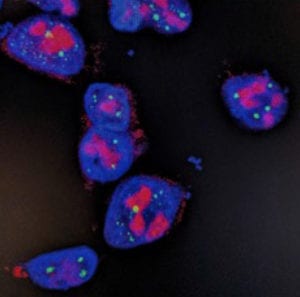 January 31, 2017 – Trading in the Scalpel for a Sharper Blade
January 31, 2017 – Trading in the Scalpel for a Sharper Blade
Losing a breast or a lung to cancer leaves a scar, both physical and emotional. But even a biopsy to determine if a tumor is cancerous, or to track a tumor’s response to drugs, brings short-term pain and can miss signs of metastasis. So, the possibility of a scalpel-free biopsy has been something of a holy grail — a way to relieve trauma, speed diagnosis and shrink medical bills. Kathleen Collins is launching a startup to develop a technology to solve this problem. More >
 January 24, 2017 – Alivisatos Receives Chemistry Award from National Academy of Sciences
January 24, 2017 – Alivisatos Receives Chemistry Award from National Academy of Sciences
Paul Alivisatos, professor of chemistry and materials science and director of the Kavli Energy NanoScience Institute, will receive the 2017 NAS Award in Chemical Sciences. Alivisatos is a pioneer in the field of nanotechnology, with work that has had important ramifications for the development of renewable energy, biomedical imaging, light-emitting devices, and other fields. More >
 January 17, 2017 – New Bakar Fellows Director Sees Berkeley’s Entrepreneurial Spirit in Faculty
January 17, 2017 – New Bakar Fellows Director Sees Berkeley’s Entrepreneurial Spirit in Faculty
Amy Herr has been appointed the faculty director of the Bakar Fellows Program, which supports faculty-led research in science, technology, engineering, mathematics, and related areas (STEM+) with the potential for positive impact through commercialization. Herr was a fellow in the program’s inaugural year, 2012. The program helped catalyze her startup, Zephyrus Biosciences, a life science tools company. More >